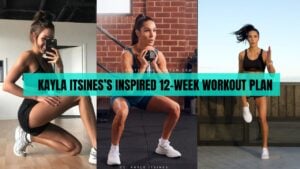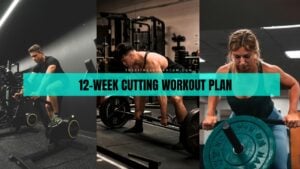In this article, I’ve rounded up the 14 best resistance band warm-up exercises for almost every muscle group. You can use those exercises to activate the muscles you want to train before weight training.
Whether you lift in the gym or train at home, starting your workout with resistance band dynamic exercises can help improve your performance and lower the risk of injuries.

Upper Body Resistance Band Warm-up Exercises
- Pull Apart
- Shoulder Pass Through
- Lying Superman Row
- Alternating Bent-over Row
- Single-arm Overhead Press
- Bent-Over Rear Delt Fly
- Standing Lat Pullover
1. Pull Apart

The pull-apart activates the back, triceps, shoulders, and chest, reduces stiffness, and prepares your upper body for resistance training.1 Fukunaga T, Fedge C, Tyler T, Mullaney M, Schmitt B, Orishimo K, McHugh M, Nicholas S. Band Pull-Apart Exercise: Effects of Movement Direction and Hand Position on Shoulder Muscle Activity. Int J Sports Phys Ther. 2022 Apr 2;17(3):400-408. doi: 10.26603/001c.33026. PMID: 35391860; PMCID: PMC8975561.
It is easy to perform and requires only a mini-loop band.
How-to Steps:
- Hold the ends of a mini band and stand upright with your feet together.
- Lift your arms and keep them straight against your chest, your hands hip-width apart.
- Pull the band apart till your arms are out completely.
- Hold for a few seconds, then return your arms to the start and repeat for the desired times.
2. Shoulder Pass Through
The shoulder pass-through involves taking the resistance band from the front of your hips to the back of your glutes.
It engages multiple torso muscles, including the shoulders, back, arms, and chest.
Whether you want to perform presses or rows, doing the shoulder pass-through just before lifting the weights can enhance your performance.
How-to Steps:
- Grab the ends of a resistance band with an overhand grip.
- Stand upright with your arms straight against your thigh.
- Raise your arms all the way from your front thighs to the glutes.
- Return to the start. Perform each rep in a deliberate manner.
3. Lying Superman Row
The Superman row targets the upper back, lower spine, and pectoral muscles, activating all primary movers so you can effectively perform compound movements, such as bent-over rows, deadlifts, and presses.
How-to Steps:
- Lie on your stomach on the mat with your arms straight against you.
- Grab a resistance band with your hands shoulder-width apart and palms down.
- Lift your chest and arms off the floor, then pull the band toward your chest.
- Feel the work for a moment, then return to the start and do it as many times as you like.
4. Alternating Bent-over Row

All we know is that the bent-over row is an incredible exercise for building muscle and strength, but some studies also suggest it puts more stress on the lower back. So, to minimize the risk of strain and increase the effectiveness, I recommend doing resistance band bent-over row before lifting real iron.
The banded bent-over row stimulates the entire back muscles, improves hip mobility, and prepares you for heavy lifting.
How-to Steps:
- Wrap the middle of the band under your feet and grab its ends firmly in each hand with a neutral grip.
- Lean forward until your chest is parallel to the floor or as far as your flexibility allows, ensuring your spine is in a neutral position.
- Keep your abdominals tight and row the band alternatively at your sides.
- Do it as many reps as possible and repeat it two to three times.
5. Single-arm Overhead Press
The unilateral shoulder press provides a full range of motion, builds strong and flexible shoulders, and promotes muscle development.
It also prepares you for all pressing movements, primarily the bench press and overhead press.
It also allows you to work more on your weaker side, which quivers during the heavy lifting.
How-to Steps:
- Wrap the one end of the band under your right foot and grab the opposite end with your right hand (with a neutral grip).
- Bend your elbow and keep your hand close to your shoulder. That’s the start.
- Press the band overhead until your arm is straight.
- Return slowly, then press it again quickly. Do the two sets of 10-15 reps on each side.
6. Bent-Over Rear Delt Fly
The reverse fly is a multi-joint warm-up exercise that simultaneously stimulates the posterior delt, trapezius, and triceps.2 Bergquist, Ronny & Iversen, Vegard & Mork, Paul & Fimland, Marius. (2018). Muscle Activity in Upper-Body Single-Joint Resistance Exercises with Elastic Resistance Bands vs. Free Weights. Journal of Human Kinetics. 61. 10.1515/hukin-2017-0137.
I recommend doing it before back and shoulder workouts to warm your muscles up before strength training.
How-to Steps:
- Stand in the shoulder-width stance, place the middle of the band under your feet, and grab its opposite ends firmly in each hand with a neutral grip.
- Bend at your hips until your chest is parallel to the floor, keeping your back straight.
- Raise your arms out until your upper back is entirely engaged.
- Feel the contraction for a few seconds, then return to the start.
7. Standing Lat Pullover
The lat pullover opens up pectoral muscles and stimulates the latissimus dorsi (the largest back muscle), providing the upper body an excellent warm-up.
I recommend doing it before doing pull exercises, especially bent-over rows, deadlifts, and T-rows.
How-to Steps:
- Anchor the band to the door at the top.
- Grab the band firmly with your hands shoulder-width apart.
- Take a couple of steps back, bend your hips, and slightly lean your torso forward.
- Contracting your lats, pull the bar until your hands reach beside your hips, ensuring your hands are straight throughout the pull.
- Pause for a moment, feel the contraction, then return to the start.
Lower Body Resistance Band Warm-up Workouts
- Suitcase Deadlift
- Clamshell
- Lateral Walk
- Glute Bridge
- Monster Walk
- Single-leg Deadlift
- Banded Good Morning
8. Suitcase Deadlift
The suitcase deadlift activates multiple muscles simultaneously, primarily the hamstrings, glutes, lower back, and some upper body muscles.
It helps improve hip mobility, make the lower spine a bit more flexible, and enhance lifts.
If you’re going to be heavy in deadlifting, I suggest starting with this banded DL for a safe and effective lift.
How-to Steps:
- Place the middle of the band under your feet, grab its ends in each hand with a neutral grip, and stand in the hip-to-shoulder width stance.
- Pushing your hips back, lower yourself, and then lift the band as you lift the bar during the deadlift.
- Maintain a straight back, keep your arms straight throughout, and perform a couple of sets of 10-15 reps.
9. Clamshell
This exercise opens up the hip adductors and glutes medius, enhancing lower body flexibility.3 Iwashita Y, Kuruma H. Examination of hip function and muscle activity during clam exercise. J Phys Ther Sci. 2023;35(7):528-532. doi:10.1589/jpts.35.528 Doing it before deadlifting or squatting can improve your performance.
How-to Steps:
- Wrap the band around your thighs and lie down on your side with your legs stacked.
- Bend your knees 60-90 degrees, keep your core tight, and then lift your top knee as high as possible without lifting your pelvis. Your legs will form a clam-shell shape.
- Pause for a moment, feel the contraction, then return to the start.
- Perform the desired number of reps, then switch to the opposite side.
10. Lateral Walk
The banded lateral walk is a functional exercise that targets the legs, glutes, and hips and builds balance and stability throughout the lower body.
Whether you’re going to squat or lift the dead weight from the floor, beginning your session with a few sets of banded lateral walks and other resistance band warm-up exercises can boost your performance.
How-to Steps:
- Wrap the band around your ankles and keep your feet hip-width apart.
- Dip in a quarter squat, then take a step with your right foot, followed by the left one.
- Do it as many times as possible, then repeat on the opposite side.
11. Glute Bridge
The glute bridge or floor hip thrust is a great exercise to activate the posterior chain, primarily the glutes maximus.
It also works on the abdominals and can be used as a warm-up exercise before bent-over rows, hip thrusts, step-ups, lunges, deadlifts, or cable pull-throughs.
How-to Steps:
- Sit on the floor with your knees bent and feet flat on the ground.
- Wrap the ends of the band around your feet and the hips.
- Lie down on the floor and keep your arms straight by your sides.
- Brace your core and glutes, and lift your hips off the ground until your knees, abdominals, and chest are in a straight line.
- Pause for two seconds, feel the work, and then return to the start. Aim for 2-3 sets of 10-15 reps.
12. Monster Walk
The monster walk involves wrapping the band around your ankles and walking forward, helping you strengthen your adductors and gluteal muscles.4 Cambridge, Edward D J et al. “Progressive hip rehabilitation: the effects of resistance band placement on gluteal activation during two common exercises.” Clinical biomechanics (Bristol, Avon) vol. 27,7 (2012): 719-24. doi:10.1016/j.clinbiomech.2012.03.002
Besides the lateral walk, you can also do this exercise to activate your lower limbs before using weights.
How-to Steps:
- Wrap the band above your ankles and stand in a shoulder-width stance.
- Slightly bend your knees and lower in a quarter squat, ensuring your core is tight.
- Take a small step to the side with your right foot, keeping tension in the band.
- Follow with your left foot, stepping in the same direction without letting your feet come together.
- Continue stepping sideways for the desired number of steps.
13. Single-leg Deadlift
Single-leg DL is a strength and balancing exercise that engages multiple muscles simultaneously, particularly the hamstrings, glutes, lower back, and core.5 Diamant, W., Geisler, S., Havers, T., & Knicker, A. (2021). Comparison of EMG Activity between Single-Leg Deadlift and Conventional Bilateral Deadlift in Trained Amateur Athletes – An Empirical Analysis. International journal of exercise science, 14(1), 187–201.
It helps develop strong, balanced, and flexible legs, which helps in other compound movements, such as deadlifts and squats.
How-to Steps:
- Place the resistance band under your right foot and grab the opposite ends with both hands.
- Lift your left leg and lean forward until your leg and torso parallel the floor.
- Pause for a moment, then return to the start in a slow and controlled fashion. Perform as many reps as possible, then switch to the opposite side.
14. Banded Good Morning
Resistance band Good Morning involves bending at your hips till your torso is parallel to the floor. It engages the hamstrings, lower back, and glutes, making the lower body flexible.6 Vigotsky AD, Harper EN, Ryan DR, Contreras B. Effects of load on good morning kinematics and EMG activity. PeerJ. 2015;3:e708. Published 2015 Jan 6. doi:10.7717/peerj.708
Doing it can alleviate stiffness in the posterior chain and help you perform better during various leg exercises.
How-to Steps:
- Wrap one end of the band around your neck and the other under your feet.
- Stand in the hip-width stance with your back straight.
- Bend at your hips and lean forward until your chest is parallel to the floor, ensuring your knee is straight throughout.
- Return your torso to the upright position until your hips are fully extended.
References
- 1Fukunaga T, Fedge C, Tyler T, Mullaney M, Schmitt B, Orishimo K, McHugh M, Nicholas S. Band Pull-Apart Exercise: Effects of Movement Direction and Hand Position on Shoulder Muscle Activity. Int J Sports Phys Ther. 2022 Apr 2;17(3):400-408. doi: 10.26603/001c.33026. PMID: 35391860; PMCID: PMC8975561.
- 2Bergquist, Ronny & Iversen, Vegard & Mork, Paul & Fimland, Marius. (2018). Muscle Activity in Upper-Body Single-Joint Resistance Exercises with Elastic Resistance Bands vs. Free Weights. Journal of Human Kinetics. 61. 10.1515/hukin-2017-0137.
- 3Iwashita Y, Kuruma H. Examination of hip function and muscle activity during clam exercise. J Phys Ther Sci. 2023;35(7):528-532. doi:10.1589/jpts.35.528
- 4Cambridge, Edward D J et al. “Progressive hip rehabilitation: the effects of resistance band placement on gluteal activation during two common exercises.” Clinical biomechanics (Bristol, Avon) vol. 27,7 (2012): 719-24. doi:10.1016/j.clinbiomech.2012.03.002
- 5Diamant, W., Geisler, S., Havers, T., & Knicker, A. (2021). Comparison of EMG Activity between Single-Leg Deadlift and Conventional Bilateral Deadlift in Trained Amateur Athletes – An Empirical Analysis. International journal of exercise science, 14(1), 187–201.
- 6Vigotsky AD, Harper EN, Ryan DR, Contreras B. Effects of load on good morning kinematics and EMG activity. PeerJ. 2015;3:e708. Published 2015 Jan 6. doi:10.7717/peerj.708






